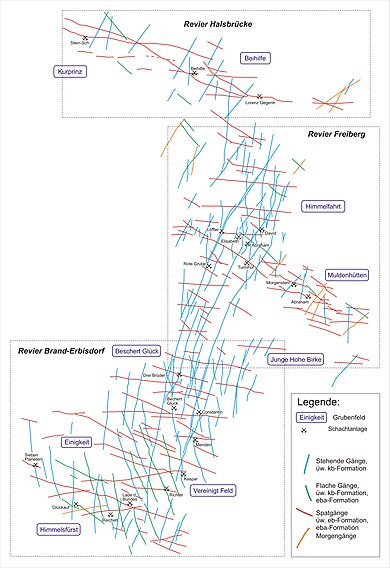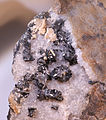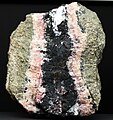Freiberg Gangerz deposit
The Freiberger Gangerzlagerstätte is a silver-containing lead - zinc - deposit . The deposit is the most important ore deposit in the Ore Mountains in terms of its spatial extent, the quantities of ore extracted and the metals extracted from it, its importance for the economic history of Saxony and the degree of geoscientific research. Geologically, it is a polymetallic, hydrothermal vein ore deposit of late to post-varietal age with over 1100 known veins. The corridors were the subject of mining operations from the High Middle Ages until the last third of the 20th century. Silver has been the primary mining metal for most of the production periods. In addition, lead and zinc as well as small amounts of copper, gold and trace metals were of economic importance in the last operating periods. The Freiberg Gangerz deposit is a sub-area of the Eastern Ore Mountains deposit district and consists of a central part and several peripheral areas. The article covers the central part of deposits.
Geographical classification
The Freiberg Gangerz deposit is located in central Saxony at the northern transition between the flat sloping Erzgebirge rock floe and the central Saxon hill country . The north-south extension is approx. 20 km, the east-west extension approx. 10 km. The terrain heights are between 420 m above sea level in the south and 360 m above sea level in the north. The cities of Freiberg , Brand-Erbisdorf and Großschirma as well as the towns of Halsbrücke and Zug are prominent centers of the deposit area.
Geology, tectonics and genesis
The geological framework of the deposit is formed by metamorphic series, such as Proterozoic orthogneiss (“Freiberg gray gneiss”, “Freiberg gneiss dome”) in the center and in the south, and ancient Paleozoic mica schist and phyllite in the north. To the east there is a granitic intrusive body (“Naundorf - Niederbobritz Granite”) and Permian porphyry dikes .
Early iron and copper mineralization took place as early as the late Proterozoic and early Paleozoic . From the late Paleozoic these rock formations were largely consolidated. With the breakup of the great continent of Pangea and the opening movements of the western Tethys as well as the Central and North Atlantic, considerable compressive and tensile stresses acted in the area under consideration during the Variscan orogeny ( Upper Carboniferous to the Permian ). As a result, a predominantly north-south-directed system of deep crevices formed within the metamorphic rocks: the shear crevice system S 1 so-called pinnacle fissure system F 1 (see figure for the tectonic structure scheme). Decisive for this orientation were not only orogenetic motion vectors, but also a rock fracture primarily in the gneiss.
Hot, aqueous metal-containing and non-metal-containing solution mixtures of magmatic origin, so-called hydrothermal solutions , penetrated the deep cracks and crevices , which were still in liquid form up to approx. 400 ° C due to the high pressure in the depths. During the cooling associated with the further ascent, the mineral sequences typical of hydrothermal deposits settled in accordance with chemical-physical laws. During this (older) cycle there was mainly the sale of economically significant mineralization consequences of the quartz-polymetallic association (older name: kb-formation, see below) and the carbonate silver-sulfide association ("eb formation", see section ore paragenesis) ).
A second (more recent) mineralization process took place during the Alpidic orogeny ( Zechstein to Tertiary ). Due to the opposite directions of movement of the African and Eurasian continental plates, the general crustal expansion stagnated and was replaced by compression and shear movements (see → continental drift ). As in the aftermath of the Variscan tectonics, another deep crevice system arose in the solid rock. These cracks and crevices formed the predominantly east-west oriented shear and pinnacle crevice system S 2 and F 2. This also created ascent routes and sales areas for hydrothermal solutions from deep magmatic crustal areas. The more recent mineralization sequences consist of the iron-barite association ("eba formation"), the fluorobarytic lead ore association ("fba formation") and the bismuth-cobalt-nickel-silver association ("BiCoNiAg formation").
In the case of Ganger ore deposits, deep-lying igneous intrusion bodies as so-called "ore carriers" were suspected or also proven to be sources of hydrothermal mineralization. For the Freiberg Ganger ore deposit, no granitic intrusion has so far been proven even with deep research boreholes over 1800 m , so that the origin of hydrothermal solutions from much deeper crustal areas must be speculatively assumed.
Deposit structure
Systematics
A basic classification of the veins in the Freiberg deposit takes place according to their orientation according to the cardinal direction:
- Standing corridors (between north and northeast)
- Morning walks (between northeast and east)
- Spatgang (between east and southeast)
- Flat corridors (between southeast and south)
More detailed explanations on this: corridor (geology) , spatial position of corridors .
For naming the veins
The names of the ore veins were mainly used in the early phase of mining and give insights into the thinking and everyday life of people in the early centuries:
- Religion: e.g. B. St. Elisabeth, Resurrection of Christ, God's gift
- Mining specifics: main adit, Rote Grube
- People: Riemer, Friederike, Siegfried, Churprinz Friedrich August
- Wishes: New hope, unexpected luck, rich mountain blessing
- Humor: It's not me, stubborn farmer, milking goat
- Fantasy: Tall Birch, White Lion, Hopfgarten
The passage name is always followed by the direction of strike according to the systematic classification. Occasionally designations were assigned twice
(see also table in Section 5.3)
mineralogy
Overview
Selection of some important ore, silver and accompanying minerals from the Freiberg deposit (the old formation name is used for better legibility)
| mining designation | mineralogical name | Chemism | formation | comment |
| Ore minerals | ||||
| Galena | Galena | PbS | kb, fba | important lead ore as well as "silver carriers" with 0.02–0.3% Ag |
| Zinc cover | Sphalerite | ZnS | kb, fba | important zinc ore |
| Pebbles | Pyrite | FeS 2 | kb, fba | Raw material for sulfuric acid production; very low, but economically recoverable gold content |
| Arsenic gravel | Arsenopyrite | FeAsS | kb | |
| Copper pebbles | Chalcopyrite | CuFeS 3 | kb, fba | important copper ore |
| Silver ores | ||||
| solid silver | .. | Ag | BiCoNiAg, eb | secondary metal concentration with 90-100% Ag |
| Silver sheen | Argentite | Ag 2 S | eb | contains up to 87% Ag |
| Silver ore | Freibergite | Ag 6 [Cu 4 Fe 2 ] Sb 4 S 13-x | eb | also "Weißgiltigerz" |
| light red gold ore | Proustit | Ag 3 [AsS 3 ] | eb | |
| Argyrodit | Ag 8 GeS 6 | eb | contains up to 74% Ag and 6% germanium (Ge) | |
| metal-free accompanying minerals ("gaits") | ||||
| quartz | quartz | SiO 2 | kb | So-called “pass-through mineral” of no economic importance, but in the deposit in varieties such as rock crystal , milk quartz, amethyst , agate , chalcedony and chert as coveted gemstones and collector's items |
| Barite | Barite | BaSO 4 | fba | Because of its relatively high density, it is the starting material for drilling fluids in the deep drilling industry |
| Fluorspar | Fluorite | CaF 2 | fba | Fluorochemical raw material (e.g. production of hydrofluoric acid). A sought-after collector's mineral because of the often perfect crystal formation and diverse colors |
| Calcite | Calcite | CaCO 3 | eb | Economically insignificant in terms of deposits, coveted collector's mineral due to the variety of crystals |
Selected mineral grades from pits in the deposit district:
Ore paragenesis
Already in the early days of Freiberg mining, different types of mineralization were detected on the veins. These revealed both differences in mineralization after the depth (“primary depth”, zoning ) and changes with the passage of the river. The result of many years of systematic exploration of the mineralization of the Freiberg Ganger ore deposit results in the mineralization sequences listed in the table below. For the sake of completeness, ore parageneses are also mentioned, which occur in the Freiberg deposit district, but were rarely or not at all detected in the central deposit area.
| designation | old name | Individual paragenesis / mineralization | comment |
| Late Varistic Mineralization Cycle (Carboniferous - Permian) | |||
| Tin-tungsten association | Sn-W | in the central part of the deposits only sporadically and in the lowest depth range | |
| Quartz-Polymetal Association | gritty-blinding (kb) formation |
|
Frequent paragenesis, preferably in north-south trending corridors (standing, flat corridors) |
| Uranium-Quartz-Carbonate Association | uqk formation |
|
Only rarely occurring in Freiberg |
| Carbonate silver sulfide association | Noble brown spar (eb) formation |
|
Developed in the southern central area (Revier Brand-Erbisdorf) and in the surrounding peripheral areas. Most important "silver formation" in the deposit district |
| Fluorite-quartz association | flq formation |
|
only regional and sporadic occurrence in the deposit district |
| Post-varic mineralization cycle (Cretaceous-Tertiary) | |||
| Iron-barite association | Iron-barite (eba) formation |
|
Developed only regionally on individual courses |
| Fluorinated lead ore association | Fluorite barite (fba) formation |
|
preferentially on WNW-ESE-trending vein crevices of the deposit district; intensively developed in the Halsbrücke district |
| Bismuth-Cobalt-Nickel-Silver Association | BiCoNiAg formation |
|
especially developed for crossings between NS- and WNW-ESE-crossing aisles. |
| Quartz Fe-Mn association | Fe-Mn formation |
|
Recent primary mineralization in the deposit disrict |
| Formations of oxidation and cementation | Formed by weathering processes in the near-surface areas of the Freiberg ore veins. In the deeper cementation zone, there is an enrichment of solid silver and silver minerals. The precious metal-rich zones led to the first heyday of mining in the High Middle Ages. | ||
Gang stages of different mineralization types from former pits of the Freiberg deposit (for reasons of space, the old formation name is used in the image descriptions)
Mining
history
The first silver (ore) find in what is now Freiberg's urban area was most likely made in 1168. According to legend, salt carters from Halle are said to have noticed an extraordinarily shiny rock in the lanes of the road on their way to Bohemia . It is not known whether Margrave Otto was awarded the Bergregal by Emperor Friedrich I (Barbarossa) . After the proclamation of freedom of the mountains, the first big " mountain shouting " was triggered. Many miners followed him, especially from the Harz region . By 1250 Freiberg had 3000 inhabitants and around 1300 about 5000. In the 13th and 14th centuries Freiberg was the largest and most economically important city of the then Margraviate of Meißen . In the 13th century Freiberg became the seat of the sovereign mining administration due to the prosperous mining industry. In addition, Freiberg was a mint from 1250 and the seat of the mining authority around 1400. The Freiberg Knappschaft was founded between 1350 and 1400.
After the mining of the near-surface rich zones and the associated need for greater depth exposure, the first crisis in Freiberg mining began at the end of the 14th century. In the 16th century there was a renewed upswing, which was documented in the establishment of the Oberbergamt (1542) and the Oberhüttenamt (1555). Numerous technical innovations, for example in tunneling technology and dewatering, were initially successful in mining. Then the mining industry and the city of Freiberg suffered severe setbacks from the Thirty Years 'War (1628–1648) and the Seven Years' War (1756–1763). By 1643 the silver production of the entire area had fallen to 1121 kg. The increasing need for qualified mining and steelworks officials led to the founding of the Bergakademie in 1765 , which had a beneficial effect on the entire mining and steel industry. At the end of the 19th century, the introduction of the gold standard in Germany led to a sharp drop in the price of silver, which led to the cessation of mining in Freiberg. The last mine was closed in 1913.
Fascist Germany's preparations for war resulted in increased demand for non-ferrous metals from 1933 onwards. From 1935 mining was resumed in Freiberg. After the end of the war, the mining and smelting operations were nationalized and in 1961 merged to form the “ Albert Funk ” mining and smelting combine . For economic reasons, the mines were finally closed in 1969, while the smelting works continued to process imported ores.
In the diagram at the beginning of the section, the metal production using the example of silver and lead (from 1520) and the workforce development (from 1800) are illustrated.
- Freiberg mining around 1900
Shaft building of the "Red Mine" (photo 1928)
- Preserved mining facilities in the area of the deposit district
technology
In the first years of the deposit development, the near-surface rich ore parts of the oxidation and cementation zone were mined by simple trenches. After they were fully exploited, the miners needed to mine the ores from the lower parts of the deposit. This was initially achieved by sinking so-called " barrel-length " shafts, that is, shafts that were driven when the corridor collapsed and from which horizontal stretches were driven into the lateral corridor areas. The main floor plan was initially 30 m, later 40 m and, since the 19th century, 60 m. The driveways on the "Gezeug sections" (soles) were preferably carried out as corridors to connect them in the rock. In addition, when penetrating ever greater depths, it became necessary to carry away penetrating groundwater or to bring in the impact water for hydropower machines via tunnel systems and drain it away again. In this way, complex systems of routes, driveways and dismantling emerged which were connected to one another by overcrowding , by climbing locations, by sinks or by blind shafts sunk in the ground . Intermediate gear parts with mineable Erzführung were in stopes - and later in the First shock - and Magazinbau won. For safety, geotechnical and economic reasons, in the last operating period the corridor sections were replaced by straightening sections driven parallel to the main stroke of the corridor in the adjacent rock .
The deepest mine operating points were at depths of 770 m (17th level at Gotthold-Gesenk, central district) and 800 m (20th gezeug section on Blindschacht I, Paulspat in the Brand-Erbisdorf district).
The solid rock and ore were loosened from the beginning over a long period of time through " hammer and iron work " and was later replaced by drilling and blasting. Nothing is known about so-called " setting fire ".
Territory organization
The central part of the Freiberg deposit district was divided into three mining districts: Halsbrücke, Freiberg (also "Central District") and Brand-Erbisdorf (also "Brander Revier"). These districts were in turn divided into pit fields. The following table provides an overview of this organizational structure. Important pits and built-up passages are listed as examples.
| Mining area | Pit field | significant pits | Selection of built-up corridors |
| Neck bridge | Elector Prince | Steinschacht, Ferdinandschacht | Ludwig, Drei-Prinzen-, Ferdinantspat |
| Aid | Aid-Richtschacht, Lorenz-Gegentrum-Schacht | Halsbrücker, Daniel, Lorenzspat, Pabst, Weisshaldner standing | |
| Freiberg (central district) | Ascension | Reiche Zeche, Elisabeth-Schacht, David-Schacht, Abraham-Schacht, Löffler-Schacht, Rote Grube | Hauptstollengang-, Silberner-Bergmann-, Rote-Grube-, War-und-Frieden-, Turmhof-standing people; Riemer-, Glückauf-, hope-Spat |
| Muldenhütten | Morgenstern-, Abrahamschacht | Good morning, Saturnus-Spat, Christof-Flacher | |
| Young tall birch | Junge Hohe Birke-, Krönerschacht | Tobias Spat, King David standing | |
| Brand-Erbisdorf | Bring happiness | Drei Brüder-Schacht , brings luck New art shaft | Johann Georg Spat, Johann Georg Standing, Hermser Trum |
| unity | - | Dornstrauch-, Three Brothers-, God's Gift-Spat, Bartholomäus-Standing | |
| United field | Kaspar, Richter shaft | Green twig spar, eagle flat | |
| Sky prince | Franken-, Glückauf-, Reichelt-, Ark des Bundes-Schacht | Neuglück Spat, Silberfund, Grünrosner, Himmelsfürst standing, Concordia morning walk |
literature
Written material
- L. Baumann, E. Kuschka, T. Seifert: The deposits of the Ore Mountains. 2001.
- L. Baumann, IL Nikolskij, M. Wolf: Introduction to geology and exploration of deposits. Verlag Glückauf, Essen 1979.
- Bayer: Die Himmelfahrt Fundgrube - a guide through the teaching and visitor mine of the TU Bergakademie Freiberg.
- M. Blechschmidt: The silver rose - European mining legends. Greifenverlag, Rudolstadt 1980.
- W. Jobst: Bergschadenkundlichen analysis Freiberg. Freiberg 1969–1973.
- H. Müller: The veins of the Freiberg mountain district. (Explanatory volume) Leipzig 1901.
- H. Pforr, R. Brendler: "Alte Elisabeth" teaching pit of the Freiberg Mining Academy. Excursion guide. Issue 1, Freiberg 1982.
- H.-J. Rösler: Textbook of Mineralogy. VEB German publishing house for basic industry, Leipzig 1979.
- S. Ulrich: The geology of the Ore Mountains. Springer-Verlag, 2013.
cards
- Geological overview map of the Free State of Saxony. 1: 400,000; Saxon State Office for Environment and Geology 1995.
- Topographic map of the Free State of Saxony. 1: 25,000, State enterprise geographic base information and surveying Saxony 2008.
- H. Müller: The veins of the Freiberg mountain district. (selected plates) 1: 25,000, Leipzig 1901, reprint Freiberg 1998.
Individual evidence
- ↑ W. SCHWABENICKY: “The high medieval mining in and around Freiberg” in: Denkmaltopographie Freiberg 2002, p. 433

































